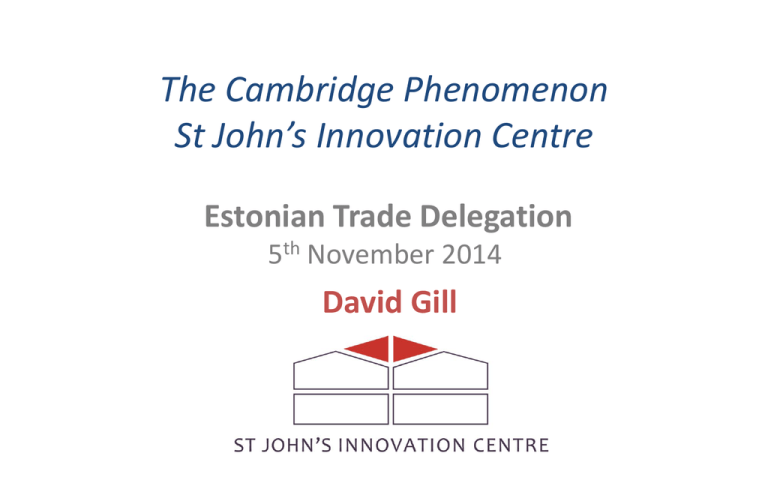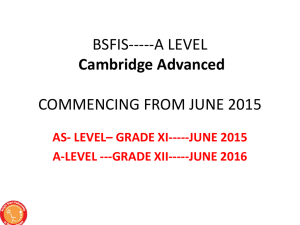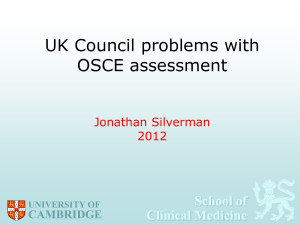The Cambridge Phenomenon. St John`s Innovation Centre. David Gill
advertisement

The Cambridge Phenomenon St John’s Innovation Centre Estonian Trade Delegation 5th November 2014 David Gill The Cambridge Cluster Today • • • • • Physical science/engineering Life sciences IT/telecoms Other (cleantech, services….) 14 x $1bn companies 2 x $10bn companies 1,500+ tech based firms Employing 57,000 people 26% of workforce in knowledge sectors (vs 12% UK average) • Generating £13bn total revenues Shanghai Jiao Tong Ranking 2014 Rank Institution Country 1 Harvard US 2 Stanford US 3 MIT US 4 Berkeley US 5 Cambridge UK 6 Princeton US 7 CalTech US 8 Columbia US 9 Chicago US 10 Oxford UK Argon Design Neul James Collier Glenn Collinson Robert Young William Webb DFJ Esprit Pronostics Steve (merged with Merged with Barlow FingerPrint Continuum Martin Renamed Acquired by Diagnostics) Photonics Frost as Broadcom AltraNova Sagentia Acquired by Dainippon Screen CMR Fuel Cells TurfTrax Steve Blatcher Michael Priestnall Cambridge Carbon Capture Green-Tide Michael Evans Turbines Michael Priestnall Michael Evans Adam Mills PlaqueTec Semblant Well Cow Frank Ferdinandi Syrris Aegate Ian Rhodes Plarion Bob Longman EXACSYS Michael Noble Rob Morland Array Logic (Plasmon) Team Consultin Andy Fry g Ian J. Smith John Poley David Edwards Jeremy Crisp Imogen Gill Bruce Macmichael John Conway Andy Thurman Adam Mills Omnisense Rob Morland Ian Hosking Intrasonics Mark Gilligan Richard Gray ADI Octymo Richard Walker Acquired by Mediatek Howard BiddleAcquired by 42 John Wilks Motorola Cambridg Tony Milbourn Technology e Design Gordon Aspin Meridica Partnershi Mark Collins Nujira Mike p Richard Fry Camitri Cognovo Beadman Tim Haynes Mike Cane Sunplus Tony Milbourn Acquired 2006 Acquired by MM Gordon Aspin by Pfizer CSR William Harrold Charles Sturman, Qasara Pascal Herczog Mark Collins Richard Fry Michael Ronny Jonckheere Barkway 2010 Pascal Herczog But…… Opportunity of a Crisis • 1845: Cambridge station, 2 miles from Centre • 1950: Holford planning guidelines – Cambridge to remain small medieval market town • Mid-1960s: IBM refused EU research HQ – • 1969: Mott Report – • Even Cambridge had to rethink Smoke-stack vs science-based industries 1970: Cambridge Science Park – – – Land owned since 1546, poor condition Vision of Sir John Bradfield, uncertain beginnings No public funding, 61.5 hectares, 145,540m2 Cambridge Cluster - Evolution 1209: Nominal foundation date - University 1534: University Press as first spin-out 1869: Cavendish Laboratory founded 1960: Cambridge Consultants formed ‘put brains of Cambridge at disposal of the problems of industry’ 1970: Cambridge Science Park 1970, first in UK Relaxation of planning laws for new industries 1985: The Cambridge Phenomenon, SQW report 350 high-tech firms, emerging cluster 1987: St John’s Innovation Centre 1987 First technology incubator in Europe How…… World-class Consultancies People & Culture • High-trust, low-touch, ‘collegiate’ culture • Now many serial entrepreneurs/angels • Recent ‘Godfathers’: – Sir John Bradfield, Dr Chris Johnson, Lord Broers, Dr Hermann Hauser, Lord Sainsbury, Walter Herriott, Matthew Bullock • ‘Superordinate goals’ Cambridge News “A Safe Place to Do Risky Things” General • • • • • Time: Cambridge cluster now 50 years old Scale: 350 high-tech firms in 1985, 1,525 today Supportive infrastructure: advisers, premises, networks Culture: entrepreneurship welcomed, many role models Reputation: brand/name assists international outreach University • • • • People: graduates most effective tech-transfer Research: blue-sky led to MRI, gene sequencing, LEDs… Values: light-touch, high-trust, bottom-up model Gravitational pull: Microsoft, Philips, Nokia, Rolls Royce… But…… The Brilliant 14 Global Successes? Mkt Cap £bn ARM t/o £m Employees 14.14 715 6.2 bought by HP 227 Bought 1.55 bought by Qualcomm 2474 Bought 0.9 335 2400 LSE 1.36 n/a 1600 LSE 0.702 bought by AZ 300 Bought ? >1000 4500 Private Globespan and then private ? Ionica >1.0 - Solexa Absorbed by Illumina Bought Bought by Celltech then UCB Bought Acambis 0.276 Bought by Sanofi-Aventis Bought Abcam 0.988 122 Autonomy Cambridge Silicon Radio Domino Printing Aveva Cambridge Antibody Technology Marshall Group Virata Cambridge Semiconductor Chiroscience 1996 LSE Conexant Merged ? Uni spin-out 1200 Crashed >650 LSE “Large Enough, But Still Intimate” • Some Cambridge ‘big’ firms no longer UK-owned • Cambridge not capable of hosting largest companies? – Infrastructure, housing and transport limitations – City Deal: 25-30% expansion 2011-31 • Much of Cambridge tech innovation is B2B: – Not faster internet/games/app B2C setors – Deep science/technology does not grow fast? • Cambridge companies need >10 years to mature The Next Generation Questions? St John’s Innovation Centre SJIC History & Purpose Established by St John’s College in 1987 to provide flexible accommodation and business support services to early-stage, knowledge-based companies A commercial business, with income paid over to St John’s College, University of Cambridge St John’s Innovation Park – in the DMZ Innovation Centre Accommodation • 53,000 sq ft of lettable space (= 4,924 m2; gross 6,100m2) • Units range from 100-3,500 sq ft in size (= 9.3 – 325 m2) • Tenants can grow by taking on more units – or moving to larger ones • Renewable leases (typically 2 years) – with only 1 month’s notice of termination for small units, – 3 months’ notice for large ones • Rates are negotiated individually • ‘Easy in, easy out’ leases Flexibility of lease is one of the success factors of the Centre Typical Tenants • Entry ±18 months after start-up • Exploiting innovation commercially • Some older knowledge-based companies: 10% • Service companies: – provide training, marketing, networking, public relations: 20% limit • Average size: 5-10 people • Average stay: 4.25 years • Around 80-90 tenants at any time • 25% Cambridge graduates • ±370 virtual tenants Some Examples – Ex-tenants • Autonomy Corporation plc, founded 1996: – Unstructured information search – 2nd largest pure software company in Europe, offices worldwide – Sold to HP October 2011 @ $10.2bn • • • • • RedGate: software tools for database administrators/developers (1999) Jagex: online computer games, including RuneScape and FunOrb (2001) Owlstone: button-sized programmable chemical sensor (2004) Breathing Buildings: low-energy natural building ventilation (2006) Amantys: intelligent power electronics – switches, drives, controls (2010) Formal Business Development • GrowthAccelerator – SME coaching programme • • • • • Aimed at firms able/willing to grow 20%+ year on year Coaching for team (< 7 days) Some workshop training (< 3 days) Specialist tracks for access to finance, innovation “The vital 6%” • Previous programme – 30 months: 950 trained/advised, ±£20m raised, 120 jobs Questions?








